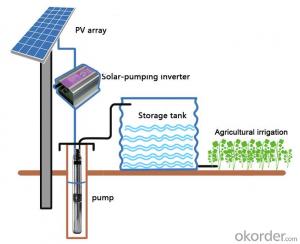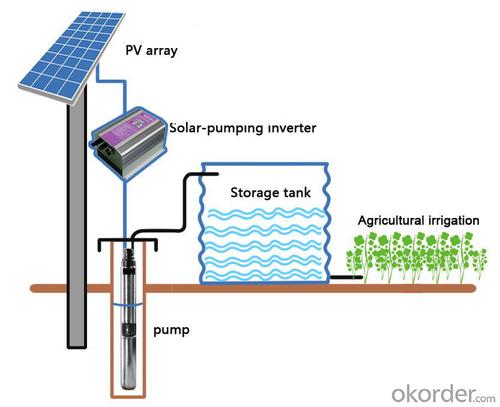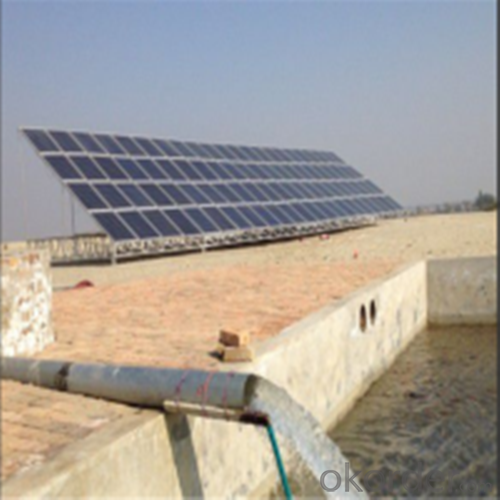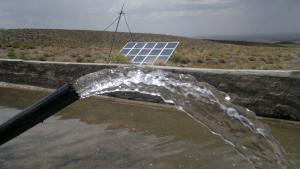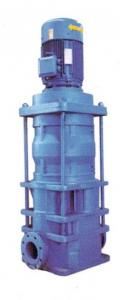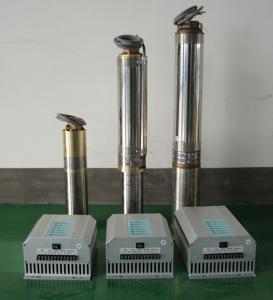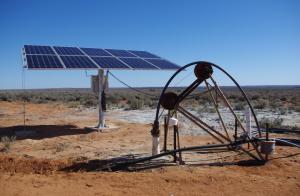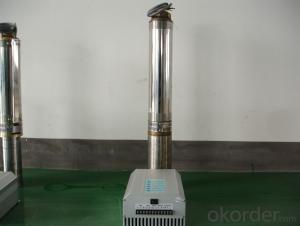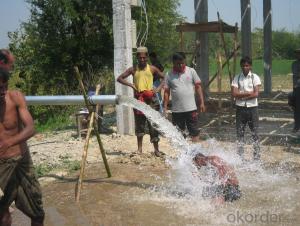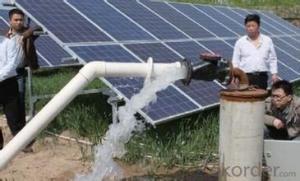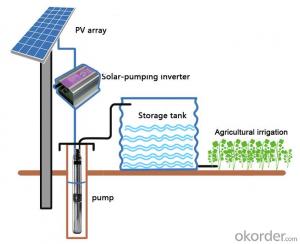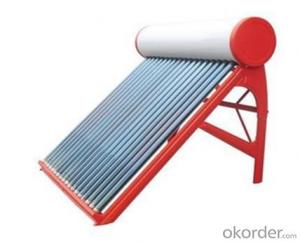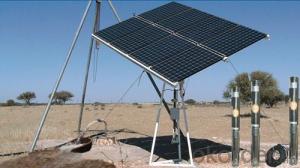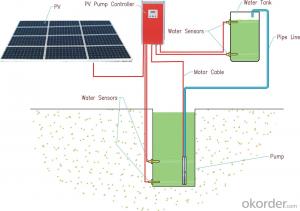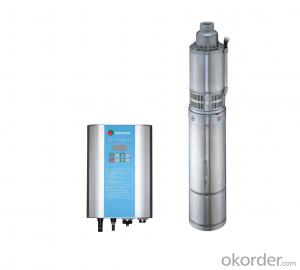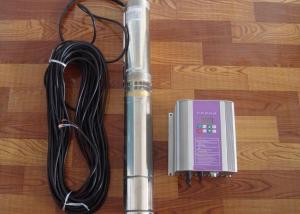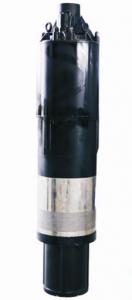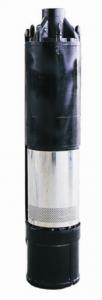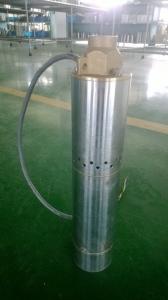Solar Panel Water Pumps with Solar Power Pumps and Battery Backup
- Loading Port:
- Shanghai
- Payment Terms:
- TT OR LC
- Min Order Qty:
- 1 set
- Supply Capability:
- 1000 set/month
OKorder Service Pledge
OKorder Financial Service
You Might Also Like
Solar Water Pump
DC solar water pumping system consists of the motor, pump, controller, solar array and some other accessories, such as water level sensor, float switch, etc. Considered that storing water is more efficient than storing electricity, the system is designed to directly drive the pump without battery which can reduce the construction and operating cost and routine maintenance effectively.The PV array consists of multiple solar panels connected in series/parallel, which can supply the whole system as power source by converting the absorbed solar radiation energy to the electrical energy. The pump driven by a brushless DC permanent magnet motor draws water from deep-well or river. The pumped water is then fed into reservoir or water tank, or connected to the irrigation system or fountain system directly.
Advanced Technology
Applications Innovation
The efficiency of DC brushless permanent magnet motor has been increased up to 25% in comparison with traditional asynchronous motor.
Technology Innovation
Stator and rotor are sealed by environment friendly casting resin.Motor insulation resistance can be hold higher than 300MΩfor more than 10 years, which consumedly increased the security and reliability of the submersible motor.
Structure Innovation
Casting resign technology processed stator and rotor as well as the water lubricated bearing make the submersible pump environment friendly.
Feature
High Efficiency & High Reliability
DC Brushless Permanent Magnet Motor
Minimum Maintenance, long Service Life
Environment Friendly Materials, Lubricated Without Oil
Application
Village or Family Water Supply
Animal Drinking Water & Livestock Watering
Garden/Courtyard Irrigation
Swimming Pool
Water Supply for Bivouac or Camping Car
Water Supply for Remote Area
Automatic Control
Operate Automatically, No Need Watching
Maximum Power Point Tracking (MPPT)
Dry-run Protection
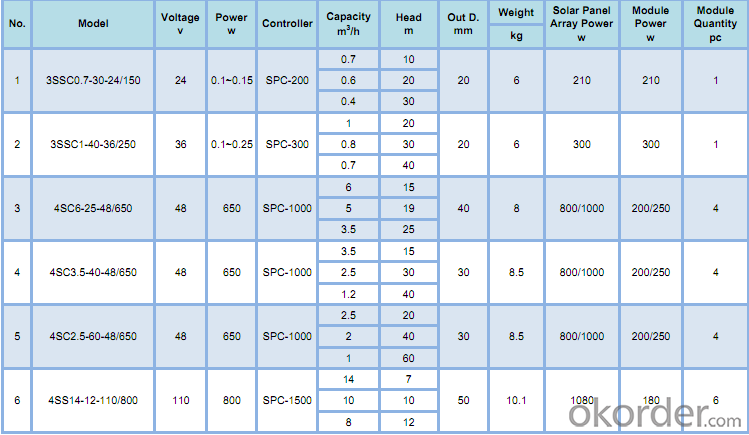
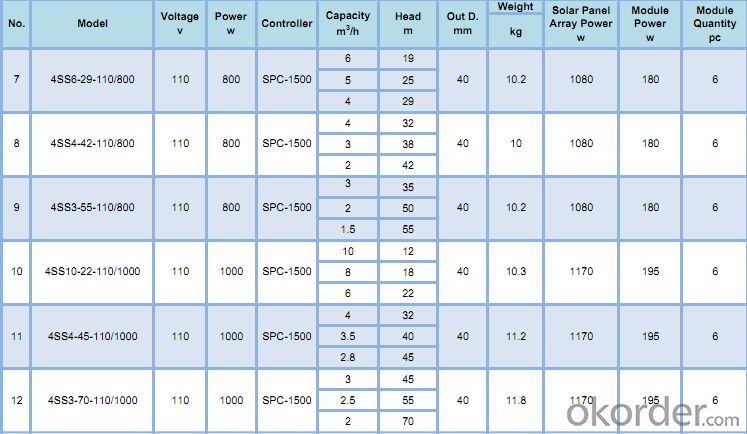
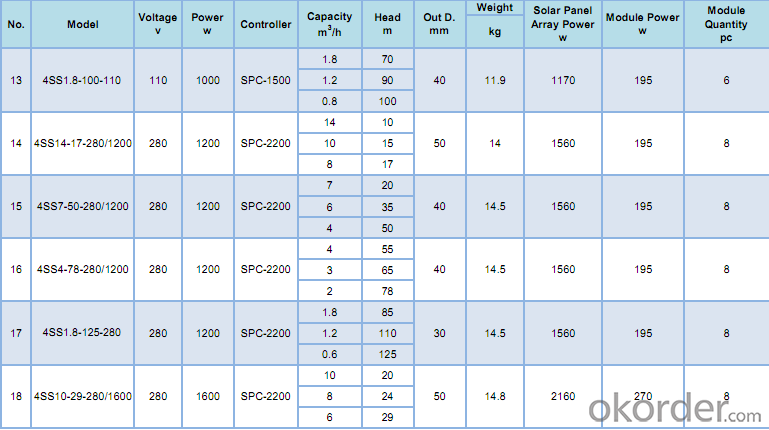
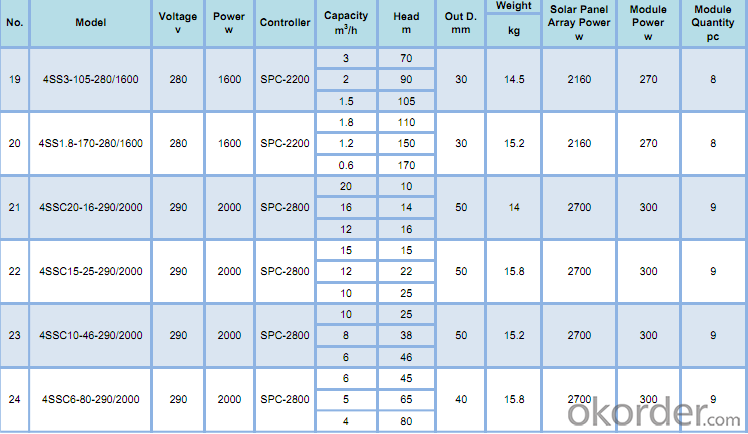
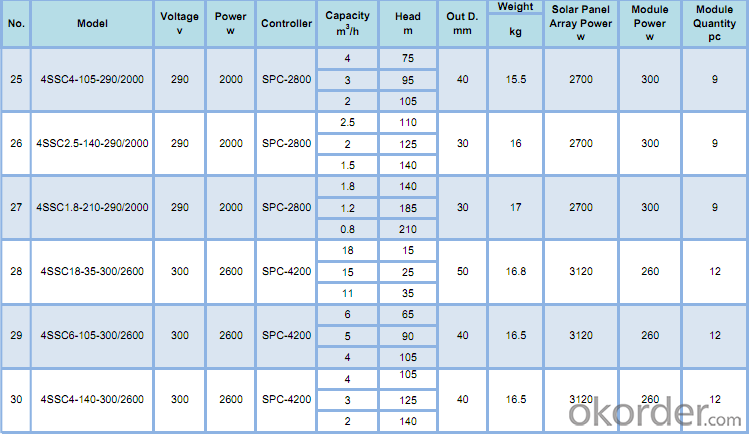
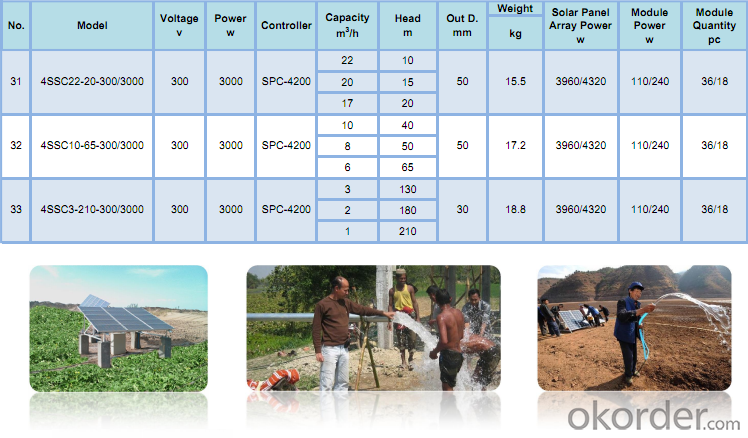
- Q: How does a solar pump help in reducing reliance on diesel generators?
- A solar pump helps in reducing reliance on diesel generators by utilizing solar energy to power the pump instead of relying on costly and polluting diesel fuel. By harnessing the power of the sun, solar pumps provide a sustainable and environmentally-friendly alternative to diesel generators, reducing operating costs and dependence on fossil fuels.
- Q: Can a solar pump be used to pump water uphill?
- Yes, a solar pump can be used to pump water uphill. Solar pumps utilize solar energy to power the pump, which can be used to lift water from a lower level to an elevated location. The efficiency of the pump may depend on factors like the power of the solar panels, the distance and height of the uphill pumping, and any potential obstacles or restrictions. However, with the right setup and sufficient power, a solar pump can successfully pump water uphill.
- Q: Do solar pumps require any additional equipment?
- Yes, solar pumps generally require additional equipment such as solar panels, a controller or inverter, and a storage tank or battery system for storing the generated energy.
- Q: What is the maximum size of particles that a solar pump can handle?
- The maximum size of particles that a solar pump can handle depends on the specific model and design. However, in general, solar pumps are typically able to handle particles up to a certain size, such as around 2-3 millimeters. It is important to consult the manufacturer's specifications for the specific solar pump being used to determine its maximum particle size handling capacity.
- Q: How does a solar pump help in reducing noise pollution?
- A solar pump helps in reducing noise pollution by eliminating the need for traditional fuel-powered pumps, which are typically noisy due to the operation of engines or motors. With a solar pump, the energy is derived from the sun's rays, resulting in a quieter and more peaceful operating environment.
- Q: Can a solar pump be used for water supply in national parks or wildlife reserves?
- Yes, a solar pump can definitely be used for water supply in national parks or wildlife reserves. Solar pumps are an excellent and sustainable alternative to traditional pumps that require electricity or fuel. They harness the power of the sun to pump water from sources such as rivers, lakes, or wells and supply it to various locations within the parks or reserves. One of the main advantages of using solar pumps in these areas is their environmental friendliness. National parks and wildlife reserves are dedicated to preserving and protecting the natural ecosystem, so using solar pumps aligns perfectly with their goals. Solar pumps produce clean energy, reducing greenhouse gas emissions and minimizing the ecological impact on the surrounding environment. Furthermore, solar pumps are highly reliable and require minimal maintenance. They operate silently and efficiently, ensuring a consistent water supply for various purposes within the parks or reserves. This can include providing water for drinking, irrigation of plants, or even for wildlife habitats and watering holes. In remote areas, where access to electricity may be limited or non-existent, solar pumps are particularly beneficial. They can be installed in off-grid locations, eliminating the need for extensive electrical infrastructure and reducing costs associated with traditional pumps. Additionally, solar pumps can be easily integrated with other renewable energy sources, such as solar panels or wind turbines, to create a sustainable and self-sufficient water supply system. Overall, solar pumps are a viable and practical option for water supply in national parks or wildlife reserves. They offer numerous benefits, including environmental sustainability, reliability, and cost-effectiveness. By harnessing the power of the sun, these pumps can contribute to the conservation efforts of these protected areas while ensuring a reliable water supply for both humans and wildlife.
- Q: How does a solar pump help in reducing carbon emissions?
- A solar pump helps in reducing carbon emissions by using clean and renewable energy from the sun to power the pump. Unlike traditional pumps that rely on fossil fuels, solar pumps do not produce any greenhouse gas emissions or air pollutants during operation. By replacing fossil fuel-powered pumps with solar pumps, we can significantly reduce carbon emissions, combat climate change, and promote sustainable development.
- Q: Can a solar pump be used in both residential and commercial applications?
- Yes, a solar pump can be used in both residential and commercial applications. Solar pumps are versatile and can be used to fulfill various water pumping needs, such as irrigation, water supply, and circulation. They are suitable for both small-scale residential use, such as watering gardens, and larger-scale commercial use, such as agricultural or industrial applications. Additionally, solar pumps offer advantages like energy efficiency, cost savings, and environmental sustainability, making them a viable option for both residential and commercial purposes.
- Q: Are there any water quality requirements for a solar pump?
- A solar pump has certain water quality requirements that need to be met. The specific requirements can vary depending on the type and design of the pump, as well as the intended use of the water. However, in general, the water quality must meet certain standards to ensure the pump operates efficiently and safely. One crucial requirement is that the water should be relatively clean and free from excessive sediment, debris, or large particles. This is because such impurities can clog or damage the pump, reducing its efficiency and lifespan. Additionally, if the solar pump is used for irrigation purposes, it is important that the water does not contain high levels of contaminants, such as salts, chemicals, or heavy metals, as these can harm plants or crops. Moreover, the water quality should be appropriate for the specific type of solar pump being used. For example, if the pump has a submersible motor, the water should not contain corrosive substances that could damage the motor components. Likewise, if the pump utilizes a filtration system, the water quality should not exceed the maximum allowable levels for the filter's capacity to effectively remove impurities. To determine the specific water quality requirements, it is essential to consult the manufacturer's guidelines and specifications for the solar pump in use. Additionally, conducting periodic water testing and maintenance can help ensure that the pump operates optimally and remains in good condition.
- Q: How does the size of the storage tank affect the performance of a solar pump?
- The size of the storage tank plays a crucial role in determining the performance of a solar pump. A larger storage tank allows for greater storage capacity, which in turn enables the pump to operate for longer durations. This is especially important during periods of low sunlight or at night when the solar panels may not be able to generate sufficient power to run the pump in real-time. With a larger storage tank, excess solar energy generated during peak sunlight hours can be stored and utilized later when needed. This ensures a continuous and consistent water supply, even in the absence of direct sunlight. On the other hand, a smaller storage tank may lead to frequent interruptions in water supply, as the pump may run out of stored energy quickly. Additionally, the size of the storage tank impacts the overall efficiency of the solar pump system. A larger tank allows for better optimization of the solar energy harvested, as it reduces the chances of energy wastage. It provides a buffer to store surplus energy during periods of high solar radiation, preventing overloading of the pump or electrical system. Moreover, a larger storage tank can contribute to better system dynamics, as it helps in maintaining a stable pressure and flow rate. It reduces the frequency of pump start/stop cycles, which enhances the overall efficiency and lifespan of the pump by minimizing wear and tear. In summary, the size of the storage tank has a direct influence on the performance of a solar pump. A larger tank increases the system's autonomy, ensures continuous water supply, optimizes energy utilization, and enhances system dynamics. Therefore, careful consideration of the storage tank size is crucial when designing and installing a solar pump system.
Send your message to us
Solar Panel Water Pumps with Solar Power Pumps and Battery Backup
- Loading Port:
- Shanghai
- Payment Terms:
- TT OR LC
- Min Order Qty:
- 1 set
- Supply Capability:
- 1000 set/month
OKorder Service Pledge
OKorder Financial Service
Similar products
Hot products
Hot Searches
Related keywords
